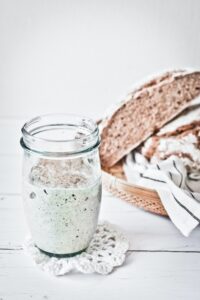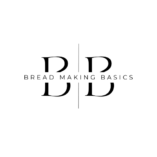
Sourdough bread has captured the hearts and taste buds of many. At the heart of this ancient bread-making tradition lies the sourdough starter which creates the characteristic flavor and rise of sourdough bread. There is something so empowering about the journey of creating, maintaining, and sharing a sourdough starter. A quality sourdough starter is the heart and soul of sourdough bread baking, a simple mixture of flour and water that, when fermented, becomes a lively culture of wild yeast and lactic acid bacteria. This living ecosystem is the secret behind the unique flavor, texture, and rise of sourdough bread.
Why You Need a Sourdough Starter:
- Natural Leavening: Unlike commercial yeast, a sourdough starter relies on naturally occurring microorganisms. This creates a complex, tangy flavor and a gentle rise, resulting in a distinctive loaf.
- Health Benefits: The fermentation process breaks down gluten and phytic acid. This process allows the bread to have a lower glycemic index, more nutrient bioavailability/absorption, and reduced gluten content. It also offers probiotic and prebiotic benefits for gut health.
- Endless Versatility: Once established, your sourdough starter can be used to bake various bread styles, from rustic boules to tender baguettes, as well as pancakes, waffles, and more.
How It Works:
When you combine flour and water and allow it to sit at room temperature, wild yeast and lactic acid bacteria naturally present in the environment and begin to colonize the mixture. This generates carbon dioxide, producing bubbles, and imparts a tangy taste. Regular feedings (discarding a portion and replenishing with fresh flour and water) at specific intervals maintain the balance and vitality of these microorganisms as well as prevent mold or other organisms from developing as they compete for fuel.
Therefore, a sourdough starter is not just a key ingredient; it’s a living entity that transforms your dough, enhances your health, and opens the door to a world of delicious bread possibilities. It’s a fundamental tool for artisanal bread making, offering the chance to explore the art and science of fermentation while delighting in the unparalleled taste of homemade sourdough.
Making a Sourdough Starter from Scratch:
Creating your sourdough starter is a satisfying and educational process. Follow these steps:
- Ingredients:
- 100g whole grain rye flour
- 100g water (non-chlorinated)
- Day 1: Mix the Ingredients: In a glass or plastic container, combine the flour and water until you have a thick, lump-free batter. Then, cover loosely with a lid or cloth and leave it at room temperature (around 70°F or 21°C).
- Days 2-7: Feed Your Starter: Each day, discard half of the starter (about 100g) and add equal parts of flour and water. You’ll notice bubbling and a sour aroma developing over these days.
- Day 7 and Beyond: Maintenance: Finally, Your starter should be active, doubling in size within 4-6 hours after feeding. Keep it at room temperature and feed it once a day. To feed or maintain your starter, keep 25g of starter and add 50g of flour and 50g of water. You will do this for well, the rest of your life.
- Using your Starter: 4-12hrs before making a sourdough loaf, feed your starter with equal parts starter:flour:water (for example: 75g, 75g, 75g) to ensure you have ample high quality starter for the bread with some left over to maintain a starter for future bread making.
There are so many resources online and a million different ways to make a sourdough starter. If you are more of a visual learner, Brian Lagerstrom has a great video explaining the process and how he recommends cultivating yeast to form a starter which varies slightly from what we wrote above. The important thing to remember here is that daily feeds are vital as they prevent mold from wining out and it gives the yeast new and fresh nutrients to cultivate a well maintained active starter.
Feeding your starter:
To keep your sourdough starter happy and active, regular feeding is key. Begin by measuring out a portion of starter and discarding the rest of the starter to make room for fresh flour and water (otherwise you will end up with an unmanageable amount of starter). Then, mix equal parts flour and water into the active starter, ensuring a consistent and thick consistency. The volume matters less than the ratio. Start with 50g Starter, 50g water and 50g of flour. Allow it to ferment at room temperature, feeding it daily or as needed to maintain its vigor. You can adjust the volume to grow your starter if needed. With each feeding, you’re nurturing the wild yeast and bacteria that give your sourdough its distinct flavor and rise.
Buying a Starter:
If you prefer a shortcut, you can purchase an established sourdough starter from a reliable source. This is a great option if you’re eager to start baking right away or if you want to try a specific regional starter. When shopping for a sourdough starter its important to consider these things below:
- Reputation: Look for well-established sourdough starter brands with a positive reputation among home bakers. Reading reviews and asking for recommendations from fellow bakers can be helpful.
- Authenticity: Ensure that the starter is indeed a naturally fermented sourdough culture and not a commercial yeast-based product. Authentic sourdough starters are made through wild fermentation.
- Variety: Consider what type of sourdough bread you want to bake. Some brands offer starters with specific flavor profiles, such as San Francisco sourdough or whole wheat sourdough. Choose a brand that aligns with your baking preferences.
- Instructions and Support: Check if the brand provides clear instructions on how to activate and maintain the starter. Good customer support can be crucial, especially if you’re new to sourdough baking.
- Packaging: Pay attention to how the starter is packaged and shipped. It should arrive in a healthy, active state. Vacuum-sealed or dehydrated starters are common.
- Organic and Non-GMO: If these factors are important to you, consider whether the brand offers organic or non-GMO sourdough starters.
While I personally have not purchased an active starter, these have come highly recommended: King Arthur Baking Classic Fresh Starter and Breadtopia Fresh Sourdough Starter. In areas with a strong artisanal or sourdough bread culture, you may be able to find local bakeries that sell their starter as part of their commitment to supporting home bakers.
**This site may contain affiliate links to products. We may receive a commission for purchases made through these links.**
Storing a Starter:
Life can get busy, and maintaining a daily feeding schedule might not always be possible.To keep your starter dormant for extended periods, consider one of two methods:
Store in Fridge:
- Place starter in the fridge after feeding.
- Feed weekly and return to fridge
- When you’re ready to bake, pull the starter out of the fridge and feed the day before baking.
OR
Drying it out and freezing:
- Spread a thin layer of active starter on parchment paper.
- Allow it to air dry until it’s brittle.
- Break it into pieces, store in an airtight container, and freeze.
- When you’re ready to bake, simply rehydrate and feed your dried starter.
What a Good Starter Looks Like:
A healthy sourdough starter should:
- Have a pleasant, slightly tangy aroma.
- Consistently double in size after feeding.
- Display an active bubbling and foaming action.
- Show signs of life within 4-6 hours after feeding.
- Be maintained with regular feedings.
- Float when placed in water
Using Discard:
When you feed your starter, you’ll often need to discard a portion to maintain its size. Don’t waste this discard; it can be used in various recipes like pancakes, waffles, biscuits, crackers, and even some cakes. We wrote a post about how to repurpose your scraps into something decadent!
Sharing a Starter with Friends:
Sourdough starters are meant to be shared, fostering a sense of community and passing on tradition. To share your starter:
- Transfer some of your mature starter into a clean jar.
- Label it with instructions for feeding and use.
- Give it to a friend or family member along with a brief guide on how to care for it.
Creating and maintaining a sourdough starter is an accessible and rewarding journey. Whether you start from scratch, purchase one, or receive one from a friend, sourdough baking will become a cherished part of your routine. Embrace the sustainable, community-driven spirit of sourdough and enjoy the delicious fruits of your labor while sharing the joy of homemade bread with friends and family. Happy baking!

Pingback: Getting Your Ratios Right When Feeding Your Sourdough Starter - Bread Making Basics